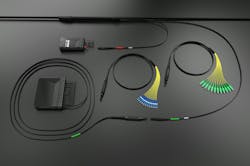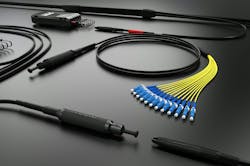Factory-Terminated Multifiber Connectivity Portfolio for Service Providers
As the first quarter of 2024 winds down and BEAD-fund disbursements get closer, service providers are grappling with the practicalities of delivering fiber for broadband services under less-than-ideal conditions. Despite some outsiders’ belief that providers will be awash in funding for these rollouts, the reality is BEAD-funded projects will have to be tightly cost-controlled based on the amount of federal funding available.
These broadband projects also will have to meet tight deployment time frames—a necessity not easily accomplished given the skilled-labor challenges many providers currently face.
As these realities and challenges have become clear over time, companies that offer technology solutions to broadband service providers have developed products, systems, services and more to meet these challenges. Long-time trusted vendors and newcomers alike are bringing to market these problem-solving solutions. One of the latest such solutions comes from a company with a history of passing 100 million homes around the globe with fiber.
On March 18 Corning introduced its Multifiber Pushlok Technology to the company’s Evolv fiber-connectivity portfolio. The new technology simplifies and accelerates fiber deployments.
“Multifiber Pushlok is a ‘stick-and-click’ connector technology that draws on Corning’s experience helping network operators reach more than 100 million homes worldwide,” the company said when making the introduction. “The compact and fiber-dense connector allows operators to deploy more fiber in tighter spaces—an essential consideration for increasing data usage.”
Corning introduced the Evolv platform in 2020 as a space-saving solution for service providers. The original Evolv product line included dual-connectivity fiber products; this latest introduction brings multifiber connectivity to the portfolio.
The Multifiber Pushlok Technology unveiling introduces three new solutions, as Corning lists and describes here.
- Evolv Assemblies with Multifiber Pushlok Technology “add flexibility to network architecture with a variety of sizes and density options. Multifiber Pushlok’s tactile and audible feedback simplifies the cable assemblies’ installation.”
- Evolv Terminals with Multifiber Pushlok Technology “include a new ‘stubless’ version that reduces packaging material by up to 30% per assembly, allowing for up to 45% more product per shipping pallet.”
- Evolv FlexNAP with MultiFiber Pushlok Technology “is preconnectorized to fit operators’ customer-specific locations, reducing their reliance on skilled labor and delivering cost savings of at least $25 per home, compared to traditional splice methods. The new system on RPX cable fits into 1.25-inch ducts, surpassing legacy solutions constrained to 2-inch ducts. This results in up to a 50% recuction in carbon footprint through minimized duct material usage. It also features a new built-in, locatable dust cap, which allows operators to swiftly locate the system for buried deployments and simplify network-troubleshooting efforts.”
“We have an unprecedented opportunity to connect the unconnected,” said Corning vice president of global market development, Bob Whitman. “There’s a lot of capital available, and we at Corning are prepared. We have decades of experience providing broadband connectivity; our technology passes more than 100 million homes globally.”
The company focuses its innovation on solving customer challenges, and these new Multifiber Pushlok technologies accomplish that in several ways, Whitman added. Today, service providers face dual challenges of cost-to-deploy broadband networks, and challenging build times for these projects—alongside labor shortages for many. Evolv’s “smaller and denser footprint make it easier to install,” Whitman said. Additionally, with the product line, “We take a lot of cost out by removing splicing from the field and into our factory,” he added. “We believe these solutions can save at least $25 per home. Because the Evolv solutions are smaller, and fit into a smaller duct, there’s also the opportunity for incremental savings. We use 35% less packaging, making it about 45% more efficient to pallet the product. And there’s up to a 50% reduction in carbon footprint.”
When asked how Evolv’s Multifiber Pushlok capabilities represent a TCD (total-cost-of-deployment) advantage over traditional fiber rollouts involving field termination, Whitman reflected, “The cost of labor is different for every carrier. Whenever we are working with them to help them decide how to build, there are different variables. [With field termination] a technician must go out with a bucket truck or climb a pole, bring the cable down to the ground, create a place to work such as a tent. Then they’re accessing the fiber by opening the cable sheath, finding the fibers, and after identifying them, strip and prepare the fiber for splicing.
“This entire process also involves variability among technicians, but it is hours long, every time it happens. We take all that and do it in our controlled-environment factory” by technicians trained specifically for that task, he emphasized. With Corning’s factory-terminated products, “You get a repeatable, reliable, lower-cost process. We know that part saves money.” With Multifiber Pushlok Evolv, rather than going through the hours-long process just described, the field technician “does a simple stick-and-click,” Whitman pointed out.
He concluded by restating the industry has arrived at a “historic opportunity to connect the unconnected. Operators are facing challenging building environments and cost constraints. We developed this solution with those challenges in mind, and we want to add on to the 100 million homes that our solutions have passed.”
About the Author
Patrick McLaughlin
Chief Editor
Patrick McLaughlin, chief editor of Cabling Installation & Maintenance, has covered the cabling industry for more than 20 years. He has authored hundreds of articles on technical and business topics related to the specification, design, installation, and management of information communications technology systems. McLaughlin has presented at live in-person and online events, and he has spearheaded cablinginstall.com's webcast seminar programs for 15 years.



